Education and science09.09.2022
How scientists of Nazarbayev University introduce "green" technologies in the field of heat supply of Nur Sultan city
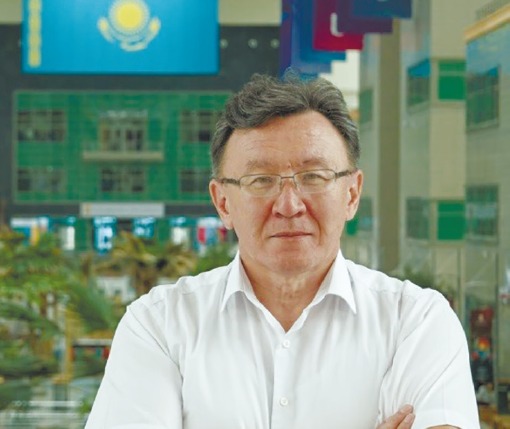
Aidar Zhakupov, CEO of PI "NURIS", Candidate of Technical Sciences
One of the recognized centers for the dissemination of knowledge and awareness in the field of renewable energy sources (RES) in Kazakhstan is Renewable Energy Testsite, operating under the PI "Nazarbayev University Research and Innovation System" (NURIS). University scientists are successfully implementing vacuum solar collectors in the local district heating system, which provide heat and hot water supply to facilities of the Nazarbayev University campus. The editorial board of QazaqGreen magazine asked Aidar Zhakupov, CEO of NURIS, Candidate of Technical Sciences, to share his achievements in this field.
- Aidar Beksultanovich, two years ago you told the readers of QazaqGreen magazine in detail about the activities of the NURIS renewable energy testsite. In social media, we observe a shift in the activity of this testsite towards the development and implementation of renewable energy in the field of heat and hot water supply. What is the reason for this change in priorities in the development of the activities of the renewable energy testsite?
- I am very pleased that you remembered my previous interview about the activities of the NURIS renewable energy testsite. Feedback from our target audience is very important to us, and we intend, along with conducting a series of webinars in the field of renewable energy, to inform our colleagues about the current achievements of the renewable energy testsite. As I noted earlier, an increase in the share of renewable energy generation by 3% in the production of electric energy in 2020 in Kazakhstan using wind turbines and photovoltaic systems, unfortunately, did not lead to an improvement in the environmental situation in cities and settlements. It is clear that the main factor of outdoor air pollution remains the traditional use of coal in heating systems of individual housing. I understand that people need a comfortable temperature in their individual housing, but it causes me emotional stress when I, a resident of the capital, cannot afford to open a window in my apartment to let some air into my bedroom before going to bed. Suffocating smog from stove heating causes a contradictory feeling among many citizens: how did it happen that we, living in the age of digital and space technologies, have not gone far from our cave ancestors, heating their primitive dwellings with fire? Therefore, we decided to intensify the activities of the renewable energy testsite in the direction of expanding the introduction of renewable energy in heating and hot water supply systems. Moreover, we had significant developments in this direction and experience in the successful implementation of a pilot project for the design and construction of an energy-efficient house in the form of a Shell-yurt, with full provision of heat from renewable energy sources (solar collectors and a heat pump).
- Can you tell us more about the system of vacuum solar collectors integrated into the local district heating and hot water supply of townhouses and cottages in the campus of Nazarbayev University?
- As facility for the installation of the system, a townhouse with a total area of 347 square meters was chosen, in which the Rastigrad kindergarten is located.
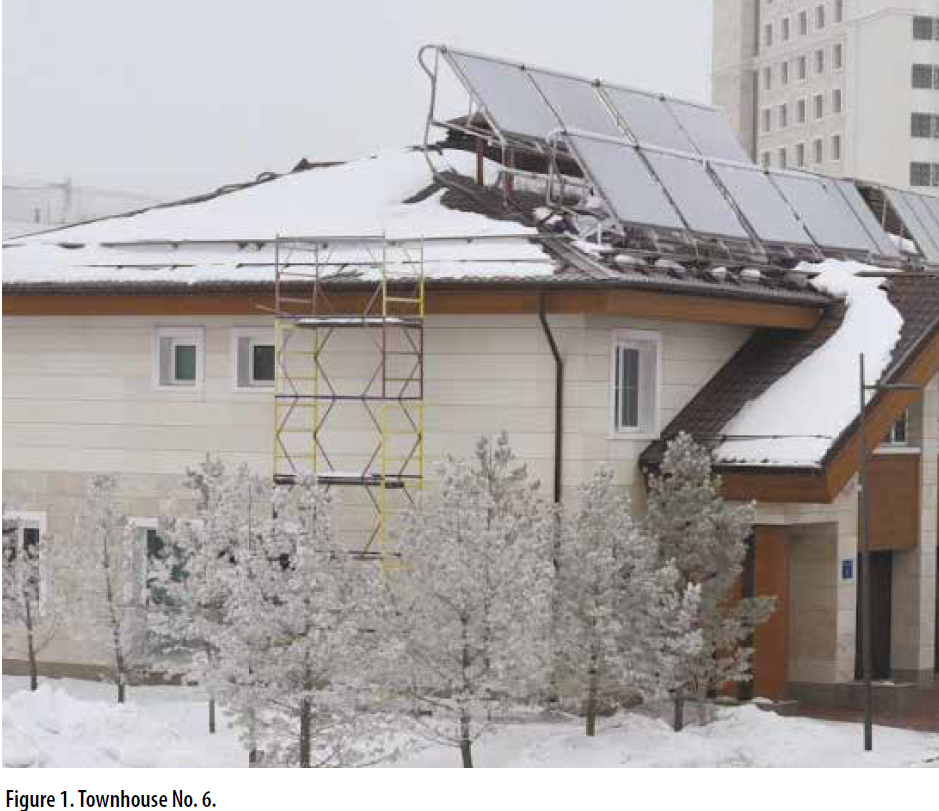
The objectives of the introduction of solar systems for heating and hot water supply are: 1) to demonstrate the use of renewable energy sources (solar collectors) for local district heating of residential buildings in the climatic conditions of Nur-Sultan; 2) to reduce CO2 emissions, reduction of energy costs for heating and hot water.
When designing the heating system, it was necessary to know the initial data:
- energy efficiency class of the building;
- required thermal power for heating and hot water supply of the facility;
- type of structural materials of the roof of the facility;
- principle and scheme of functioning of the existing (traditional) heating system.
The energy efficiency class of the building is high (B+). This indicator means that the building effectively consumes thermal energy and has a deviation from the standard value in the range from -30 to -40%.
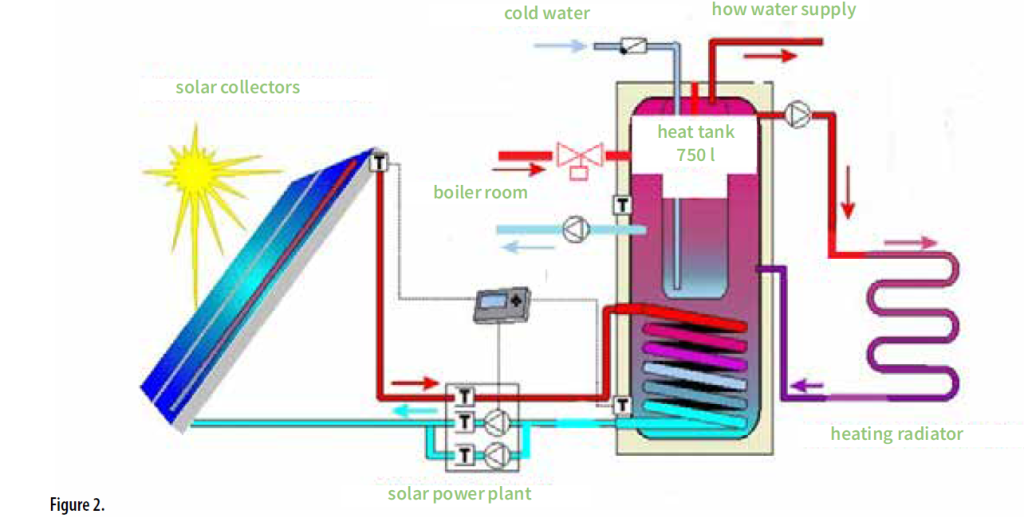
The equipment was selected based on modeling and calculations performed. The schematic diagram of the heating system with solar systems is shown in Figure 2, and the mnemonic circuit displayed on the PC is shown in Figure 3.
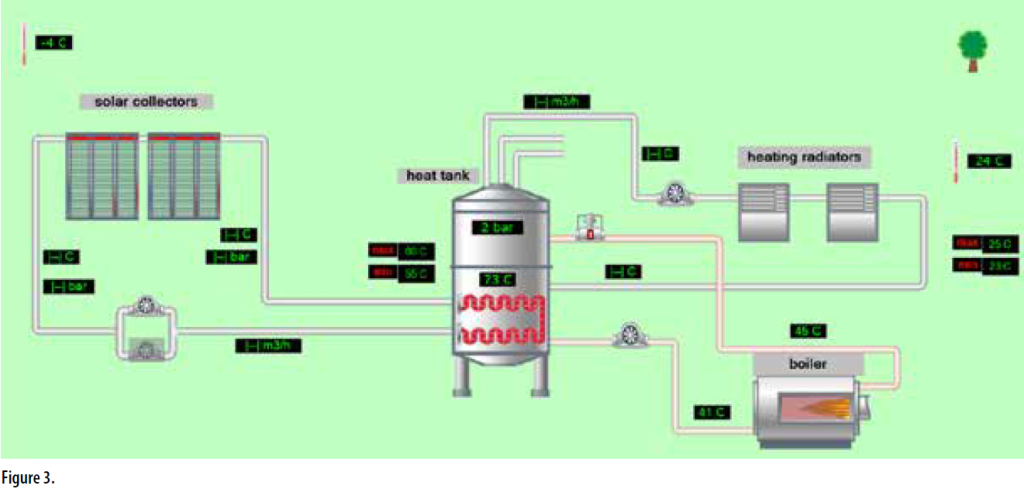
The heating and hot water supply system based on solar collectors works together with the heating scheme from the boiler house of PI "USM". The location of the thermal equipment was chosen by the premises of the thermal point of townhouses.
System Characteristics:
• The thermal power of the GC - 17.5 kW;
• The volume of the heat tank - 750 liters;
• Heating and hot water supply;
• Heat sources: solar collectors, boiler room
• Separate use of heating sources;
• Automatic control and regulation of thermal parameters.
The heating system is capable of performing the following functions:
- heating of residential building from the energy of sunlight;
- automatic switching of heating system sources: solar collectors or boiler room;
- possibility of automatic temperature control in the house;
- accounting and archiving of thermal parameters;
- visualization of the heating system operation in real time on a computer.
- How effective is the implemented solar collector system in operation?
- Description of the efficiency of the solar system, let's start with a comparative table of the heat consumption of two townhouses - No. 10 and No. 6:

In February, heat savings on heating and hot water amounted to 31%, or 33.3 thousand tenge. In March and April, the savings in heat consumption for heating and hot water amounted to 45% and 49%, or from 26 to 30 thousand tenge, respectively.
In order to understand how effectively the solar system works, let's consider the diagram of the thermal energy consumed by townhouses No. 6 and No. 10, as well as the generation of heat from the solar system.
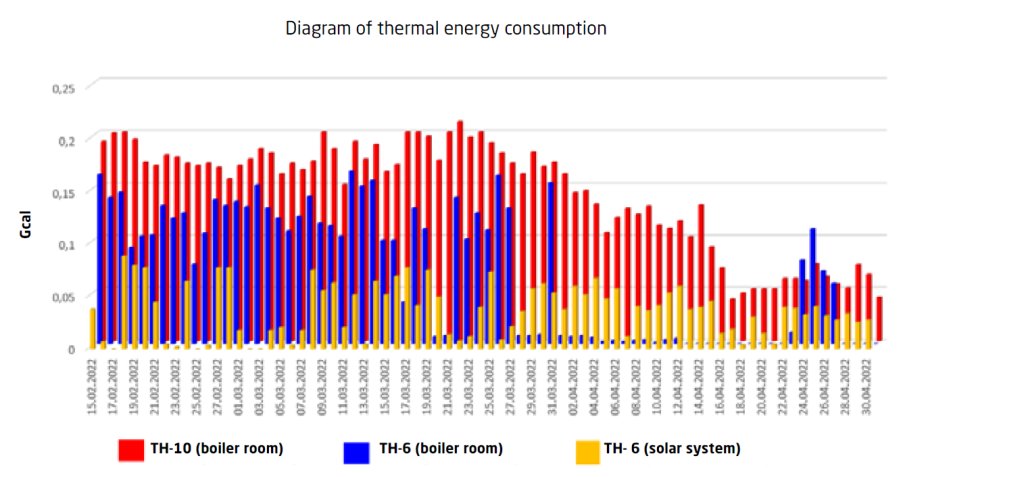
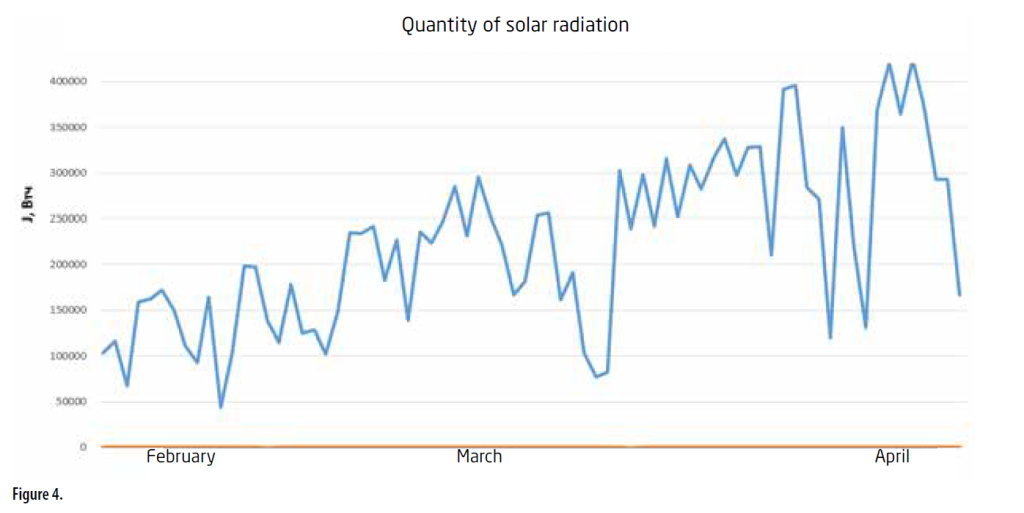
In the period from February to March, there is a small number of sunny days, which leads to a reduction in heat consumption from the boiler room of townhouse No. 6 in comparison with townhouse No. 10.
In April, there is a large number of sunny days and an increase in the average daily air temperature, the efficiency of heat generation by solar collectors increases, which leads to the absence of heat consumption for heating and hot water supply (DHW) of townhouse No. 6 from the boiler room.
Based on the analysis of the indications of heat consumption and the generation of thermal energy for heating and hot water supply by an indirect method, the efficiency indicators of the use of solar collectors were calculated.
Key performance indicators:
- reduction of CO2 emissions, if liquefied gas were burned, to 1.0 t
- reduction of energy consumption for background heating up to 80%
- reduction of energy consumption for hot water supply with year-round use up to 75%
- reduction of the volume of liquefied gas burned to 500 cubic meters.
General conclusions can be drawn:
1. The use of solar collectors as a heat source for heating and hot water supply for individual housing is possible in the climatic conditions of Nur-Sultan.
2. The use of solar systems is especially effective in a combined heat supply system when there is a main heat source (heat pump or gas boiler).
3. Scaling up the use of solar systems for individual housing should be considered as an innovative solution to reduce CO2 emissions.
- We are all witnessing a large-scale growth in the number of new solar and wind power plants in Kazakhstan. Recently, information appeared in the media about the development of a draft law "On heat power engineering". Do you and your colleagues plan to initiate the introduction of the necessary standards so that renewable energy sources can be actively introduced in Kazakhstan's heat supply systems?
- Yes, you are absolutely right, the improvement of the regulatory framework for supporting renewable energy has significantly affected the positive dynamics and progress achieved in the field of decarbonization and decentralization of the electric power industry using renewable energy. The current net consumer rate allows owners of individual housing with renewable energy sources to sell electricity at the same rate at which electricity is purchased from an electricity supply organization, or to make offsets. Therefore, I also consider it an urgent need to actively participate in the improvement of legislation in this area. Our colleagues from the renewable energy testsite in June took part in two meetings of working groups on development of the draft law "On Heat Power Engineering" (DLRK). We have also made our proposals to supplement the two articles of the DLRK concerning the inclusion of measures of state support for the use of renewable energy systems in heat supply systems. These are Article 16 "Local district heating system" and Article 17 "Individual heating system".
Currently there are active discussions about the form in which state support for use of renewable energy in heating and hot water supply systems will be implemented. This may be the reimbursement of part of the cost of RES equipment costs or the purchase of thermal energy from RES at the same rate at which the heat supply organization releases the energy to consumers. This means that practice of supporting RES through the mechanism of a net consumer of electric energy can be extended to the practice of supporting RES net consumer of thermal energy.
We hope that in the process of discussing DLRK, our proposed standards will be included, and we will achieve significant progress in integrating renewable energy with traditional heating and hot water supply systems. This will lead to an improvement in the environmental situation in cities and will be able to breathe clean air.
- Aidar Beksultanovich, thank you for an interesting interview!
Thank you, I also thank the editors of QazaqGreen magazine for the opportunity to share NURIS' achievements in the field of renewable energy.
Samruk-Energy expands strategic cooperation with leading Chinese energy companies
Chinese energy developers build solar power plant in Kazakhstan's Mangistau region
Balcony solar power systems gain ground in Lithuania
JA Solar to supply 1GW of PV modules for Masdar’s solar projects in Azerbaijan
Moldova to integrate floating solar and wind power into hydropower infrastructure
World's most powerful direct-drive floating wind turbine unveiled in China
California becomes world’s largest economy powered by two-thirds clean energy
Mobarakeh solar breakthrough ushers new era for Iran industry
Norway unveils floating greenhouse that produces food, fish, and clean energy
New additive strategy enhances efficiency of bifacial perovskite solar cells
India tests a totally-new source of energy
Kazakhstan and UAE reaffirm strategic energy partnership with 1 GW wind project
Solar becomes EU’s top power source for the first time ever
How decentralised renewables transform healthcare services in rural Zimbabwe
Chinese company to build solar and wind power plants in Kyrgyzstan
Seaturns raises €2.45 million to industrialize wave energy technology and accelerate global rollout
Trump signs executive order to end subsidies for wind and solar energy
Uzbekistan's solar and wind power plants generate 5 Billion kWh since beginning of the year
Green Corridor Alliance JV registered in Baku to promote green energy development in Central Asia and the South Caucasus
In the EU renewable energy supply grew by 3.4% in 2024











